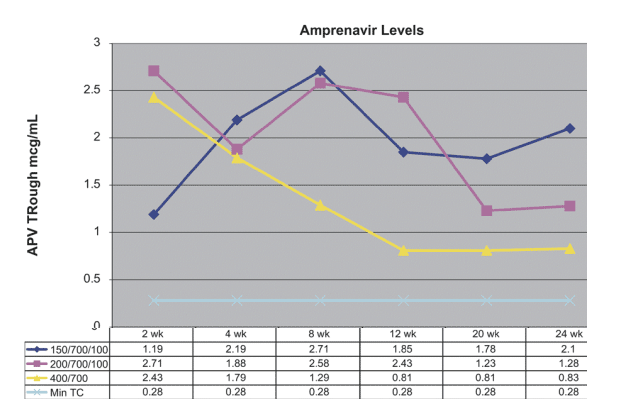| |
Interaction Between Atazanavir and Fosamprenavir in the Treatment of HIV-Infected Patients
|
| |
| |
JAIDS Journal of Acquired Immune Deficiency Syndromes: Volume 41(1) 1 January 2006 pp 124-125
Khanlou, Homayoun; Bhatti, Laveeza; Farthing, Charles
AIDS Healthcare Foundation, Los Angeles, CA
Letter To the Editor:
Many patients with multidrug-resistant HIV have limited options for salvage antiretroviral therapy. Until new and more potent agents are available, physicians often must design new regimens with current available antiretroviral agents to control HIV viremia and maintain CD4 counts. The use of dual-boosted protease inhibitor (PI)-containing regimens is one option that may offer several benefits.1 Pharmacokinetic enhancement of 2 different PIs with low-dose ritonavir may result in a higher genetic barrier to resistance and possibly in synergistic activity against HIV. The combination of atazanavir, fosamprenavir, and minidose ritonavir may meet these criteria. Given that fosamprenavir is an inducer of CYP-3A4 metabolism, potential dose alterations and longer follow-up may be warranted.
We examined the trough concentrations (Ctrough) of atazanavir and fosamprenavir in treatment-experienced patients receiving atazanavir + fosamprenavir + ritonavir who have been intolerant to or have failed lopinavir/ritonavir for a duration of 24 weeks and followed their CD4 and HIV RNA levels. Seventeen patients were selected. Nine patients were given a combination of atazanavir 150/fosamprenavir 700/ritonavir 100 mg twice daily, and 5 patients atazanavir 200/fosamprenavir 700/ritonavir 100 mg twice daily. Three patients did not tolerate ritonavir and were switched to atazanavir 400/fosamprenavir 700 mg twice daily. The Ctroughs were analyzed using a centralized laboratory with validated techniques (Consolidated Laboratory Services, Van Nuys, CA). The minimum Ctrough of atazanavir and amprenavir were defined, respectively, as 0.27 mg/mL and 0.28 mg/mL.
None of the patients were receiving concomitant nonnucleoside reverse transcriptase inhibitors. Nine of 14 patients on boosted regimens (3 on atazanavir 200 mg) were receiving tenofovir 300 mg and emtricitabine 200 mg once daily as part of a nucleoside reverse transcriptase inhibitor backbone, and 2 patients were on fixed-dose zidovudine/lamivudine/abacavir twice daily and 1 was on abacavir + lamivudine twice daily. Two patients were on dual-boosted PIs only (1 with history of lactic acidosis and the other with severe lipoatrophy). The other 3 patients on nonboosted combinations were on abacavir and lamivudine twice daily.
All regimens produced atazanavir and amprenavir Ctrough well above the minimum acceptable concentrations (Figs. 1 and 2). At 24 weeks, the 3 regimens did improve CD4- cell count (average: +151 vs. +134 vs. +95 cells/mm3) and reduce HIV RNA (average: -2.6 vs. -2.11 vs. -3.7 log10, respectively). Overall, at week 24, 10 of 17 patients (60%) achieved HIV RNA levels <400 copies/mL and 4 of 17 (24%) had <50 copies/mL. Interestingly, 2 patients with a very high level of resistance in the protease gene (one with 9 significant mutations including V82A and L90M, and another with 12 significant mutations including I84V and L90M) responded to <50 copies/mL. At 24 weeks, the average total cholesterol levels were 195 vs. 237 vs. 177 mg/dL and triglycerides 210 vs. 196 vs. 177 mg/dL, respectively. One patient on 150 mg/700 mg/100 mg developed grade 3 hyperlipidemia at week 8 and stopped ritonavir with improvement. Four patients did receive concomitant statins.


Overall clinical tolerance was excellent, particularly vis-a-vis the digestive system. However, the occurrence of hyperlipidemia constitutes a limiting factor. In addition, the numbers on a nonritonavir regimen were too small to draw any conclusion, but the lower Ctroughs are of concern.
Among different PIs, it appears that combination of atazanavir and fosamprenavir with low-dose ritonavir could offer a great pharmacokinetic advantage, allowing concentrations above the relevant IC50 (50% inhibitory concentration) to be achieved safely. This is of importance in the clinical setting, particularly in the presence of multidrug-resistant HIV infection with an increase in the Cmin:IC50 ratio. Previous studies have shown that higher atazanavir Ctrough levels (ie, 0.774-0.850 mg/mL) were more likely to reduce viral load in experienced patients.2,3
However, in the absence of ritonavir inhibition, the Ctrough of atazanavir was low, requiring administration of an extra dose of atazanavir (400 mg twice daily). The use of therapeutic drug monitoring did allow for adjustment of dosing in patients in whom ritonavir was not used because of patients' preference, intolerability, or history of severe hyperlipidemia. In these patients, although the Ctrough may have been acceptable for wild-type virus, a dose increase was thought to be necessary.
Another implication of these findings is the importance of therapeutic drug monitoring in the treatment of HIV-infected patients, particularly in those with advanced-stage disease in whom the use of numerous drugs and thus many interactions are expected.
In conclusion, these results appear to indicate that a combination of atazanavir 150 or 200 mg twice daily and fosamprenavir 700 mg twice daily with low-dose ritonavir may offer adequate Ctrough values for both drugs and may be a viable option for some treatment-experienced patients. Further larger studies evaluating the pharmacokinetics, the effect on P-glycoprotein, and plasma-protein-binding, the virologic efficacy, and the synergism of this combination are perhaps warranted.
|
|
| |
| |
|
|
|